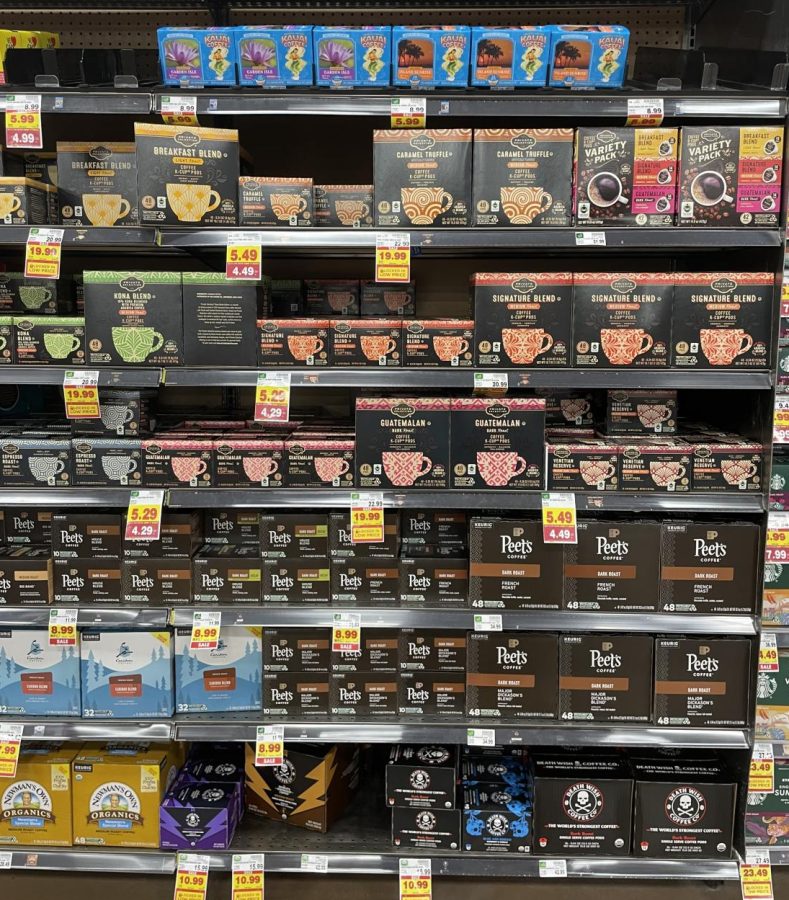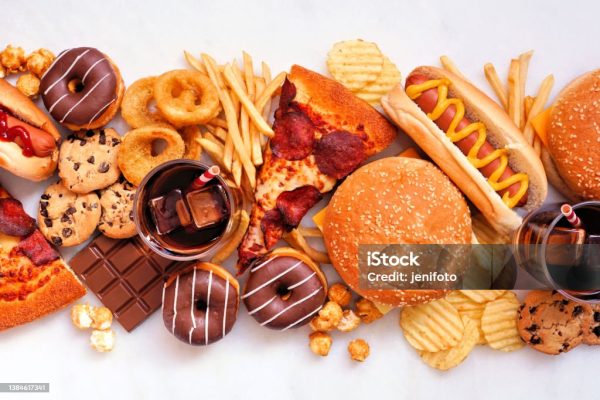Caffeine’s Captive: You
Almost everyone drinks caffeine, but could it be a leading health issue we’re staying too calm about?
Coffee shelf at Kroger.
Occasionally, the time for a jolt of energy emerges. Possibly you had been studying the previous night before for an exam. Your eyes draw closed. Maybe you were attending a sporting event. You begin to feel an ache. Perhaps, you were desiring an assist. For whatever reason it may be, the sorcery will likely be caffeinated.
Effectively, caffeine is a central nervous system stimulant. The chemical, trimethylxanthine (tri-methal-xan-thene), increases one’s awareness and tires out the sleepy chemical: melatonin. On average, drinking caffeine beverages is a quick fix to a night too late or morning too early; however, can this quick fix lead to an underlying, long-term health issue?
According to WebMD, four out of five adults consume caffeine daily. Depending on the type of tea, an average cup contains 14 to 60 milligrams of caffeine, compared to an average-size cup of coffee, which supplies 200 milligrams of caffeine. Though, the recommended safe amount is a caffeine consumption of 400 milligrams (equal to 4 cups of brewed coffee). In particular, the suggestion only applies to adults– those fully grown and developed. The issue, in relation to teenagers, fares otherwise.

Teenagers
Typically, teenagers weigh lighter than full-grown adults; therefore, the effects of caffeine are twice as influential to teens than they are to adults.
The majority of caffeine kids consume is found in sodas; yet, still, there isn’t a standard amount of caffeine for children, but it is typically advised to keep your children from sugar additives. According to pediatricians from the American Academy of Child & Adolescent Psychiatry, children under the age of 12 should not ingest caffeinated food or drinks. Obviously, the reality that is there are numerous foods or drinks containing caffeine, but the encouragement is to limit or consume them in moderation. Those older than 12 can safely consume 85–100 milligrams a day. Visually, this is two 12 oz soda cans or 1 to 2 cups of tea.
Traveling to Australia in 2018, the HCF, collected information on adolescent caffeine consumption by survey, resulting in 15% of adolescents consuming caffeine regularly. Teenagers, those ages 14–17 consume an average of 5.5 cups of caffeinated tea a week. Yet, the safe amount of caffeine for teenagers, those aged under 17 is 100 milligrams, as reported by UT Health Houston. Reasonably so, the results are alarming. The development of an adolescent should be taken with care for optimal growth and repair. The myth that stunts growth is an old wives’ tale, in the means of science, no evidence stands to support this claim.
As mentioned in HCF studies, developing teens are prone to be sensitive to stress and addiction. In this regard, the shift of caffeine dependency has the potential to increase significantly.
Detrimental Energy Drinks

Within recent years, the interest in energy drinks has skyrocketed. More than ever before, teenagers are resorting to energy drinks as their quick fix. Whether blind-sighted or not, teens are risking their health in trade for receiving harmful side effects of consuming highly caffeinated drinks, to provide a temporary mood or energy boost.
In totality, energy drinks are life-threatening. To make matters worse, energy drinks are legally available to anyone who wishes to lay their hands on them.
In the year 2013 of February, an issue of the journal Pediatrics in Review reflected on existing research and concluded that caffeine-laden energy drinks can cause rapid heartbeat, high blood pressure, obesity, and other medical problems. Caffeine overload can also increase agitation, anxiety, and behavioral issues.
A Wolf In Sheep’s Clothing
To many, this merely appears as a consumer issue, but the marketing and advertisement for caffeinated drinks are among the larger issues.
Knowingly, manufacturers promote the drink as a dietary supplement to teenagers or athletes. Each drink is filled with rich flavors and sugar high it delivers, but it is poor nutritive. The higher the dosage, the more damage.
Generally, energy drinks are advertised or even shown on TV as commercials, and if they’re not on TV they’re on another platform that has streaming services. Purely, the constant reminder of energy drinks exist, is enough for the normalcy of energy drinks. The attitude toward energy drinks becomes less threatening and more tolerated.
From the Cleveland Clinic, one study found that 43 percent of 13-to-15-year-olds had tried them. Energy drinks strictly improve focusing factors but not cognitive abilities or tasks. Depending on the size of the can, some energy drinks hold more than one serving. Take, for instance, Monster Energy drinks, the serving size for a single can is two.
According to the CDC, “In 2011, 1,499 adolescents aged 12 to 17 years went to the emergency room for an energy drink related emergency.” Additionally, The American Academy of Pediatrics recommends that adolescents do not consume energy drinks, yet between 30–50% reported consuming energy drinks.
Interestingly enough, The National Federation of State High School Associations recommends that young athletes should not use energy drinks for hydration, and information about the potential risk should be widely distributed to young athletes.
Some of the dangers of energy drinks include:
- Dehydration (not enough water in your body).
- Heart complications (such as irregular heartbeat and heart failure).
- Anxiety (feeling nervous and jittery).
- Insomnia (unable to sleep).
In today’s world, caffeine is slowly shifting its way into younger people’s lives. Regardless of health professions’ guidance.

MeiLi is a WCHS senior; this is her first-time reporting for The Jacket Journal. She has run for four years on WCHS’s cross-country team. She is a driven...






